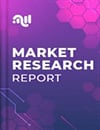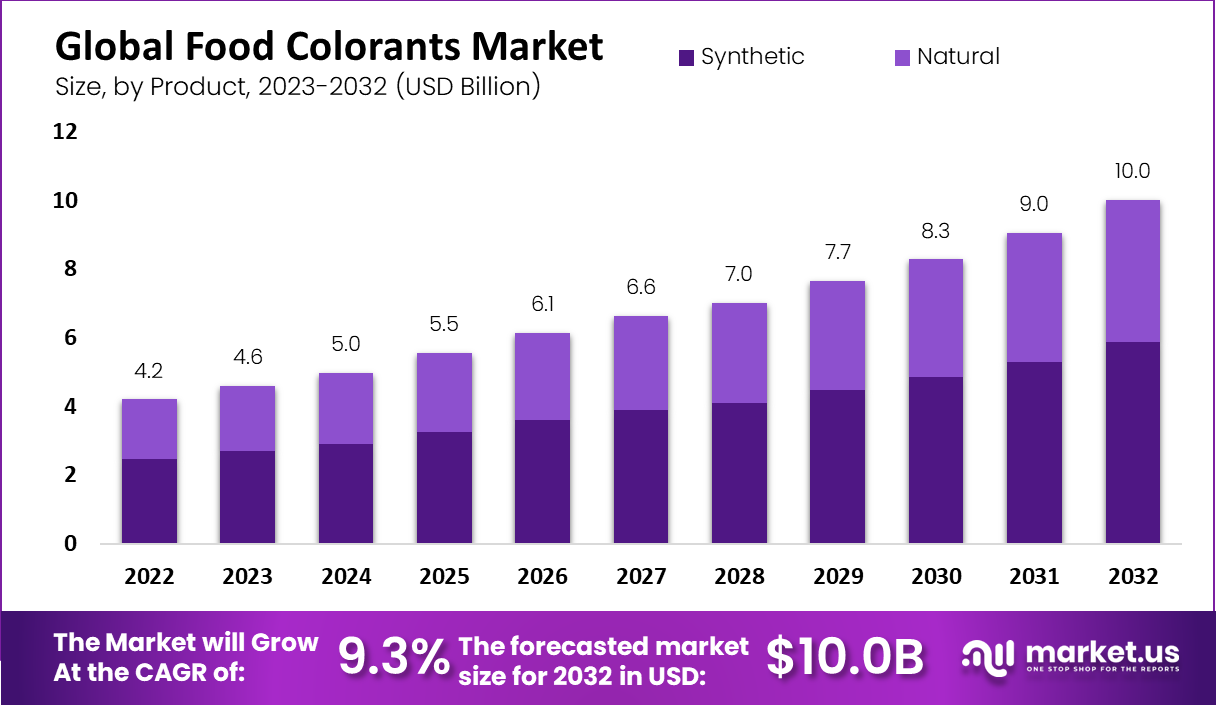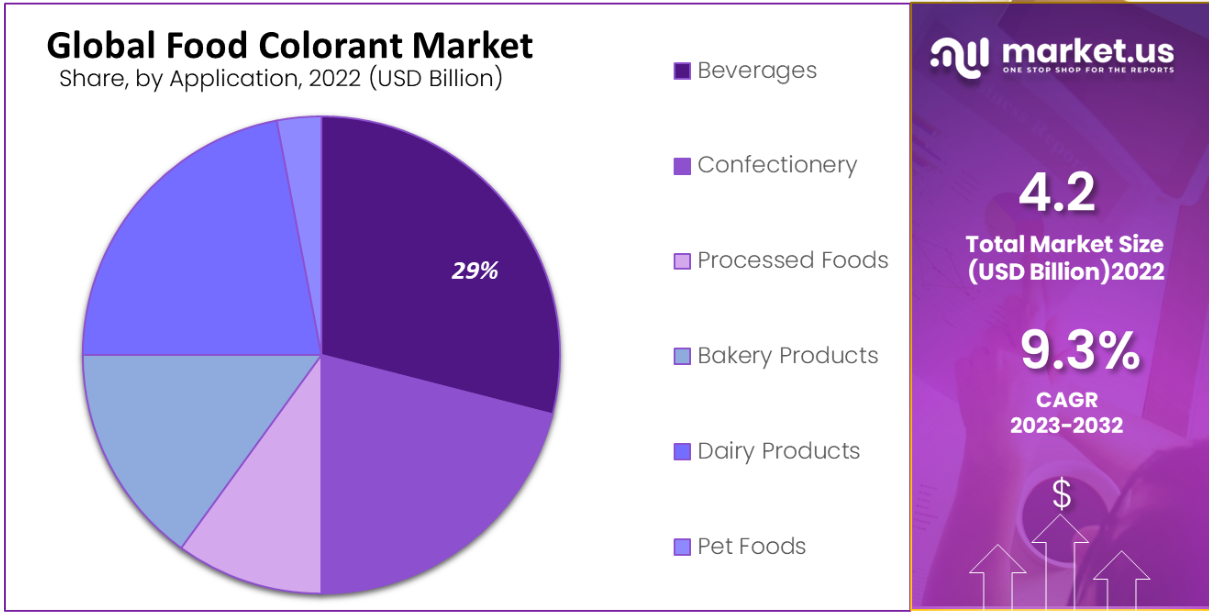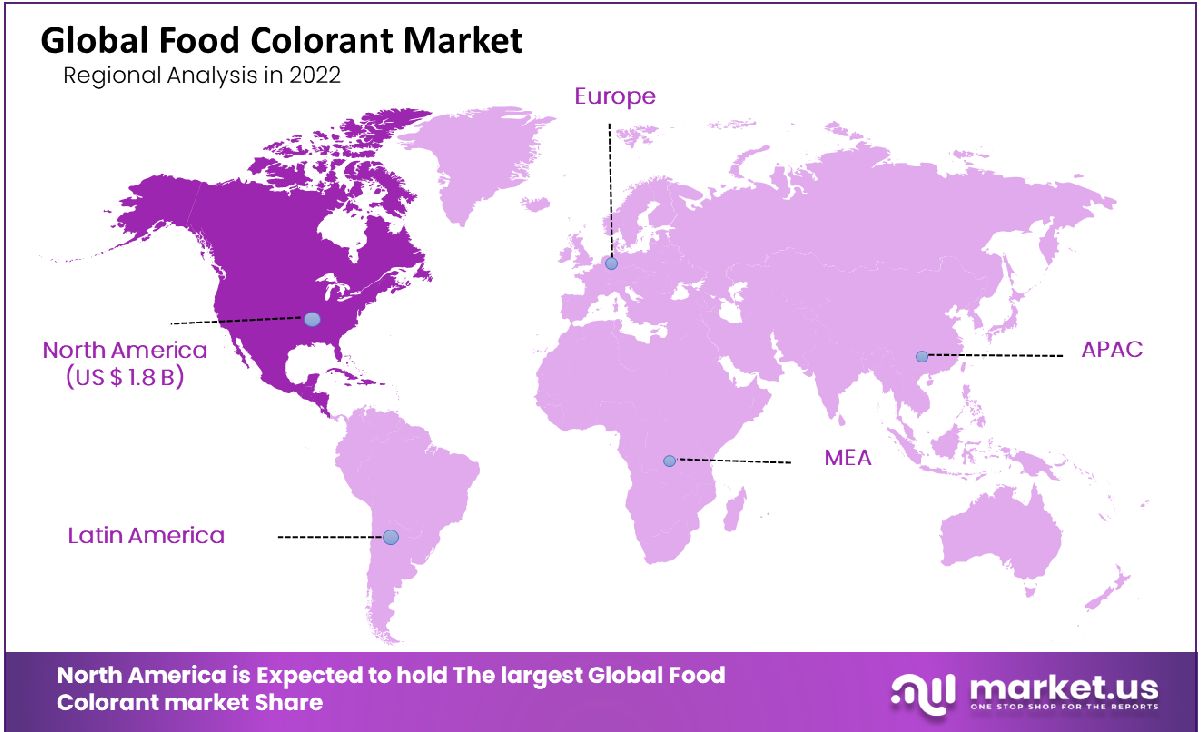Global Food Colorants Market by Type (Synthetic and Natural), By Application (Beverages, Confectionery, and Others), By Region and Companies - Industry Segment Outlook, Market Assessment, Competition Scenario, Trends, and Forecast 2023-2032
- Published date: Oct 2023
- Report ID: 28470
- Number of Pages: 296
- Format:
- keyboard_arrow_up
Quick Navigation
Report Overview
In 2022, the Global Food Colorants Market was valued at USD 4.20 billion and is expected to grow around USD 10.0 billion between 2023 and 2032, this market is estimated to register the highest CAGR of 9.3%.
Food coloring is a dye, pigment, or substance that gives color when added to food or beverages. Food colors are available in a variety of forms, including liquids, powders, gels, and pastes, and are used in meat products, beverages, dairy products, bakery, confectionery products, processed foods & vegetables, and oils & fats. Food coloring does not necessarily mean that the ingredients are organic, but in some cases, it means that fewer of the ingredients are used.
The fewer ingredients you add, the more natural the food becomes. The food coloring market includes natural and artificial colors. Natural food colors are derived from a wide range of plants, vegetables, minerals, fruits, and other edible natural sources. These colors are physical and/or Obtained by a chemical process. Artificial colors are chemical compounds used to add flavor to food, improve its appearance, or enhance the flavor properties of food.

The growth of the global food coloring market is driven by increasing demand for natural colors from various end-use industries such as food & beverages, bakery & confectionery, dairy, meat & poultry, and seafood. This should have a positive effect on the use of natural sources of curcumin, carotenoids, anthocyanins, carmine, etc.
Natural colors are free of genetically modified organisms (GMOs) and allergens. They act as antioxidants and pigments, protecting the body against cellular damage, chronic disease, and signs of aging. For example, red sandalwood offers wound-healing properties and is used in Ayurvedic treatments. Thus, growing awareness of the health benefits of natural colorings is driving the growth of the food colorings market.
Key Takeaways
- Market Size and Growth: In 2022, the Global Food Colorants Market was valued at US$ 4.20 billion. It is projected to grow to approximately USD 10.0 billion between 2023 and 2032. The market is estimated to register the highest Compound Annual Growth Rate (CAGR) of 9.3% during this period.
- Definition of Food Colorants: Food colorants are dyes, pigments, or substances used to add color to food and beverages. They are available in various forms, including liquids, powders, gels, and pastes. These colorants are used in a wide range of products, including meat, beverages, dairy, bakery items, confectionery, processed foods, and more.
- Natural and Artificial Colorants: Food colorants can be categorized into natural and artificial colors. Natural colors are derived from plants, vegetables, minerals, fruits, and other edible sources. Artificial colors are chemical compounds used to enhance the appearance and flavor of food.
- Drivers of Market Growth: Increased consumption of processed foods and beverages is a major driver. Consumers’ growing awareness of the health benefits of natural colorings is boosting the market for natural food colors. Consumers are seeking products made with plant-based ingredients to avoid synthetic additives.
- Regulatory Challenges: There are strict regulations regarding synthetic food colors due to potential health concerns. Some synthetic colors have been linked to carcinogens and hyperactivity in children.
- Types of Food Colorants: The market includes both synthetic and natural food colorants. Synthetic colorants are widely used due to their low cost and availability. Natural colors, though growing in popularity, are less known to consumers.
- Dominant Application Segment: The beverages sector was the most dominant in the food colorants market in 2022. The beverage industry is evolving to meet consumer demands for convenience and natural ingredients.
- Regional Analysis: North America leads the global food colorant market, driven by a high consumption of packaged foods. Europe also has a significant market for natural food colors. Asia-Pacific’s growing urbanization and increased consumption of ready-to-eat snacks contribute to market growth.
- Key Players: Major players in the food colorants market include Dohler Group, ADM Company, Ingredion Inc., and Sensient Technologies. Symrise AG is a leading manufacturer of flavors and fragrances with a presence in multiple
Drivers
Increased Consumption of Processed Foods and Beverages
The increasing number of workers and modernization are driving the consumption of processed and packaged foods. Increased consumption of processed foods such as instant snack foods, soft drinks, ready-to-eat foods, and processed dairy products has increased the use of various food colorings. These colors are mixed and blended into processed foods and beverages to give them an attractive appearance.
Food attractiveness is equally important to consumers as it is to the raw materials used to manufacture the food. Pigments and dyes are the most commonly used food colorings in food. , and for beverages, liquid colorants, and gels are used. The use of these colors varies by product. The majority of soft drinks and carbonated beverages contain more food coloring than food.
In the coming years, the food coloring market will grow rapidly due to the growing consumption of soft drinks in developing countries. Make it possible. Consumers are aware of the harmful effects of various synthetic ingredients used in food, and regular consumption can lead to a variety of health hazards. Allergy problems arise.
As such, consumers prefer to purchase products made with plant-based ingredients. The use of natural colors and pigments has come into the limelight as consumers become more aware of their various health benefits.
Natural or plant-based colors are becoming more popular due to their health benefits. This creates a market opportunity. It reduces consumer allergy risk and creates opportunities for manufacturers in the natural color market.
Restraints
Severe Regulations Restraining Food Coloring Market Growth
Synthetic food colors have carcinogens and other allergens. To overcome this, there are various strict regulations imposed by various national associations to overcome this. Artificial colors such as Red 40, Yellow 6, and Yellow 5 have been tested for carcinogens that can cause cancer.
A study conducted by the British government concluded that the consumption of artificial and synthetic colorings leads to hyperactivity in children aged 8 to 9. A common coloring agent in soft drinks, caffeine, can cause palpitations. According to the FDA (Food and Drug Administration), animal studies have shown that the synthetic colors Red 40, Yellow 6, Yellow 5, Blue 2, Blue 1, and Green 3 exhibit cancer properties in laboratory animals.
Type Analysis
Synthetic Type of Food Colorant Drives Market Growth
On the basis of type, the global food coloring market is divided into synthetic and natural types. The market is expected to grow at an accelerated pace due to the wide acceptance of these coloring agents in major economies and developing countries.
By type, synthetic colorants are expected to hold the largest market share due to their low cost and ready availability in the market. There are several types of synthetic food colors used in foods and beverages that help increase attractiveness, appetite stimulation, and consumer appeal. Over the years, with various strict rules and regulations from various federal agencies, the demand for synthetic chemical colors is expected to grow slowly.
On the other hand, natural colors are expected to grow at the fastest CAGR of 9.67% due to a high consumer preference for natural ingredients. Nature-identical food dyes are chemically produced but have the same molecules that are present in natural food dyes. Due to low consumer awareness of this type of food coloring, CAGR is slowing. Caramel is commonly used in candy-making because of its color and flavor. Consumer acceptance of these types of paints is a key growth factor in the global market.
Application Analysis
The Beverage Segment Dominates the Market Growth
Beverages, dairy & frozen products, bakery, meat, poultry, seafood, confectionery, sauces, condiments, and others make up the application-based food colorants market segmentation. In 2022, the beverages sector was the most dominating in the market.

The beverage industry is experiencing a significant shift in innovation to meet newer consumer trends as attention shifts to convenience foods and beverages. Along with the rapid demand for ready-to-drink and on-the-go drinks, consumers are becoming increasingly curious about the ingredients and where they come from.
Key Market Segments
Type
- Synthetic
- Natural
Application
- Beverages
- Confectionery
- Processed Foods
- Bakery Products
- Dairy Products
- Pet Foods
Opportunity
Rising Demand for Natural Food Products
The growing demand for natural foods has led food manufacturers to make extensive use of natural colors to restore the appeal of processed food and beverage products. The demand for organic food is constantly increasing due to the increasing health consciousness of consumers and awareness of the negative effects of conventionally grown foods.
Many natural food colors are used in organic foods to increase shopper appeal and influence purchasing decisions.
Trends
Increasing Consumer Shift Towards Clean Label Products and Ingredients
Demand for clean-label raw materials creates demand for this market. It is clear that consumers are shifting away from chemical ingredients to completely natural and chemical-free products. This shift is clearly due to consumer perceptions of the different health hazards these chemical ingredients pose compared to plant-based ingredients.
This tremendous change from consumers has led various food and beverage manufacturers to consolidate the production of clean-label ingredients and the use of clean-label ingredients in finished food products. Producing food in this way brings clear transparency to the supply chain and its production practices.
Regional Analysis
North America Dominates the Global Food Colorant Market
The global food coloring market is mainly driven by robust consumption of packaged foods in major economies such as North America, Europe, and Asia Pacific. The market for natural and synthetic colors is growing across North America as consumers purchase more carbonated beverages. The European region has a similar market to North America, with the highest sales of natural food colors in particular. The growing ban on synthetic dyes for ecological and toxicological reasons has increased the demand for natural food coloring.
Increased urbanization and westernization have increased the consumption of packaged food. These foods contain natural, synthetic, or artificial food coloring, depending upon requirements. Consumer awareness of natural ingredients in food and beverages. Consumers’ knowledge of label reading and ingredients in this region contributes to the growth of the natural food coloring market.

The high population density in the Asia-Pacific region has led to the consumption of a variety of ready-to-eat snacks, creating demand for these colors. The increasing labor force in the region is a major driver of market growth. In South America, on the other hand, growth is slowing throughout the forecast period due to factors such as regulatory challenges, deteriorating economic conditions, and consumer health concerns. However, the region is expected to see a high preference for packaged foods.
Key Regions and Countries
- North America
- The US
- Canada
- Mexico
- Eastern Europe
- Russia
- Poland
- The Czech Republic
- Greece
- Rest of Eastern Europe
- Western Europe
- Germany
- France
- The UK
- Spain
- Italy
- Portugal
- Ireland
- Austria
- Switzerland
- Benelux
- Nordic
- Rest of Western Europe
- APAC
- China
- Vietnam
- Japan
- Indonesia
- South Korea
- India
- Australia & New Zealand
- Singapore
- Thailand
- Malaysia
- Philippines
- Rest of APA
- Latin America
- Colombia
- Chile
- Brazil
- Argentina
- Costa Rica
- Rest of Latin America
- Middle East & Africa
- Algeria
- Egypt
- United Arab Emirates
- Saudi Arabia
- Kuwait
- Nigeria
- Israel
- South Africa
- Turkey
- Rest of the Middle East and Africa
Key Players Analysis
The structure of the global food coloring market is highly organized as a result of the dominance of several key players in the market. The manufacturer is working to increase the transparency of his supply chain and manufacturing companies. The market is dominated by Dohler Group, ADM Company, Ingredion Inc, and Sensient Technologies.
It is expected that these players will hold the largest share of the food collar market. Symrise AG is one of the leading manufacturers of flavors and fragrances. Our line of food colorings is manufactured within the Flavors & Nutrition segment. The company operates in multiple locations in his more than 40 countries across the United States, Latin America, Asia Pacific, the Middle East, Africa, and Europe.
Market Key Players
- DDW The Color House
- IFC Solutions
- Natural Food Color
- Neelikon Food Colours & Chemicals
- Accurate Color & Compounding
- Northwestern Extract Co
- KIK Danville
- Sensient Colors LLC
- WILD Flavors and Specialty Ingredients
- Kolor Jet Chemical Pvt
- Food Ingredient Solutions LLC
- Other Key Players
Recent Developments
- In January 2021, GNT Group added a new pink colorant under the EXBERRY® brand called EXBERRY Shade Pink – OD, designed for fat-based applications. There are also red, yellow, orange, blue, and green variations.
- In October 2020, Chr. Hansen Natural Colors established an R&D center in Montpellier, France, to expand its pigment, formulation, and application capabilities and introduce new natural color solutions, especially in shades of green, blue, and brown.
- In January 2020, Azelis and BASF agreed on a partnership for health ingredients and colorants in the Greek food and beverage and nutraceutical market segments.
Report Scope
Report Features Description Market Value (2022) US$ 4,20 Bn Forecast Revenue (2032) US$ 10.0 Bn CAGR (2023-2032) 9.3% Base Year for Estimation 2022 Historic Period 2016-2022 Forecast Period 2023-2032 Report Coverage Revenue Forecast, Market Dynamics, COVID-19 Impact, Competitive Landscape, Recent Developments Segments Covered By Type: Synthetic and Natural; and By Application: Beverages, Confectionery, Processed Foods, Bakery Products, Dairy Products, and Pet Foods. Regional Analysis North America – The US, Canada, & Mexico; Western Europe – Germany, France, The UK, Spain, Italy, Portugal, Ireland, Austria, Switzerland, Benelux, Nordic, & Rest of Western Europe; Eastern Europe – Russia, Poland, The Czech Republic, Greece, & Rest of Eastern Europe; APAC – China, Japan, South Korea, India, Australia & New Zealand, Indonesia, Malaysia, Philippines, Singapore, Thailand, Vietnam, & Rest of APAC; Latin America – Brazil, Colombia, Chile, Argentina, Costa Rica, & Rest of Latin America; Middle East & Africa – Algeria, Egypt, Israel, Kuwait, Nigeria, Saudi Arabia, South Africa, Turkey, United Arab Emirates, & Rest of MEA Competitive Landscape DDW The Color House, IFC Solutions, Natural Food Color, Neelikon Food Colours & Chemicals, Accurate Color & Compounding, Northwestern Extract Co, KIK Danville, Sensient Colors LLC, WILD Flavors and Specialty Ingredients, Kolor Jet Chemical Pvt, Food Ingredient Solutions LLC, and Other Key Players Customization Scope Customization for segments, region/country-level will be provided. Moreover, additional customization can be done based on the requirements. Purchase Options We have three licenses to opt for: Single User License, Multi-User License (Up to 5 Users), Corporate Use License (Unlimited User and Printable PDF) Frequently Asked Questions (FAQ)
What is the projected CAGR at which the Food Colorants Market is expected to grow at?The Food Colorants Market is expected to grow at a CAGR of 9.3% (2023-2032).
Which region is more appealing for vendors employed in the Food Colorants Market?The global food coloring market is mainly driven by robust consumption of packaged foods in major economies such as North America, Europe, and Asia Pacific.
Name the key business areas for the Food Colorants Market.The US, Canada, China, India, Brazil, South Africa, Singapore, Indonesia, Portugal, etc., are leading key areas of operation for the Food Colorants Market.
List the segments encompassed in this report on the Food Colorants Market?Market.US has segmented the Food Colorants Market by geography (North America, Europe, APAC, South America, And Middle East and South Africa). The market has been segmented By Type Synthetic, Natural. By Application Beverages, Confectionery, Processed Foods, Bakery Products, Dairy Products, and Pet Food

- DDW The Color House
- IFC Solutions
- Natural Food Color
- Neelikon Food Colours & Chemicals
- Accurate Color & Compounding
- Northwestern Extract Co
- KIK Danville
- Sensient Colors LLC
- WILD Flavors and Specialty Ingredients
- Kolor Jet Chemical Pvt
- Food Ingredient Solutions LLC
- Other Key Players
- settingsSettings
Our Clients
| Single User $4,599 $3,499 USD / per unit save 24% | Multi User $5,999 $4,299 USD / per unit save 28% | Corporate User $7,299 $4,999 USD / per unit save 32% | |
|---|---|---|---|
| e-Access | |||
| Report Library Access | |||
| Data Set (Excel) | |||
| Company Profile Library Access | |||
| Interactive Dashboard | |||
| Free Custumization | No | up to 10 hrs work | up to 30 hrs work |
| Accessibility | 1 User | 2-5 User | Unlimited |
| Analyst Support | up to 20 hrs | up to 40 hrs | up to 50 hrs |
| Benefit | Up to 20% off on next purchase | Up to 25% off on next purchase | Up to 30% off on next purchase |
| Buy Now ($ 3,499) | Buy Now ($ 4,299) | Buy Now ($ 4,999) |












